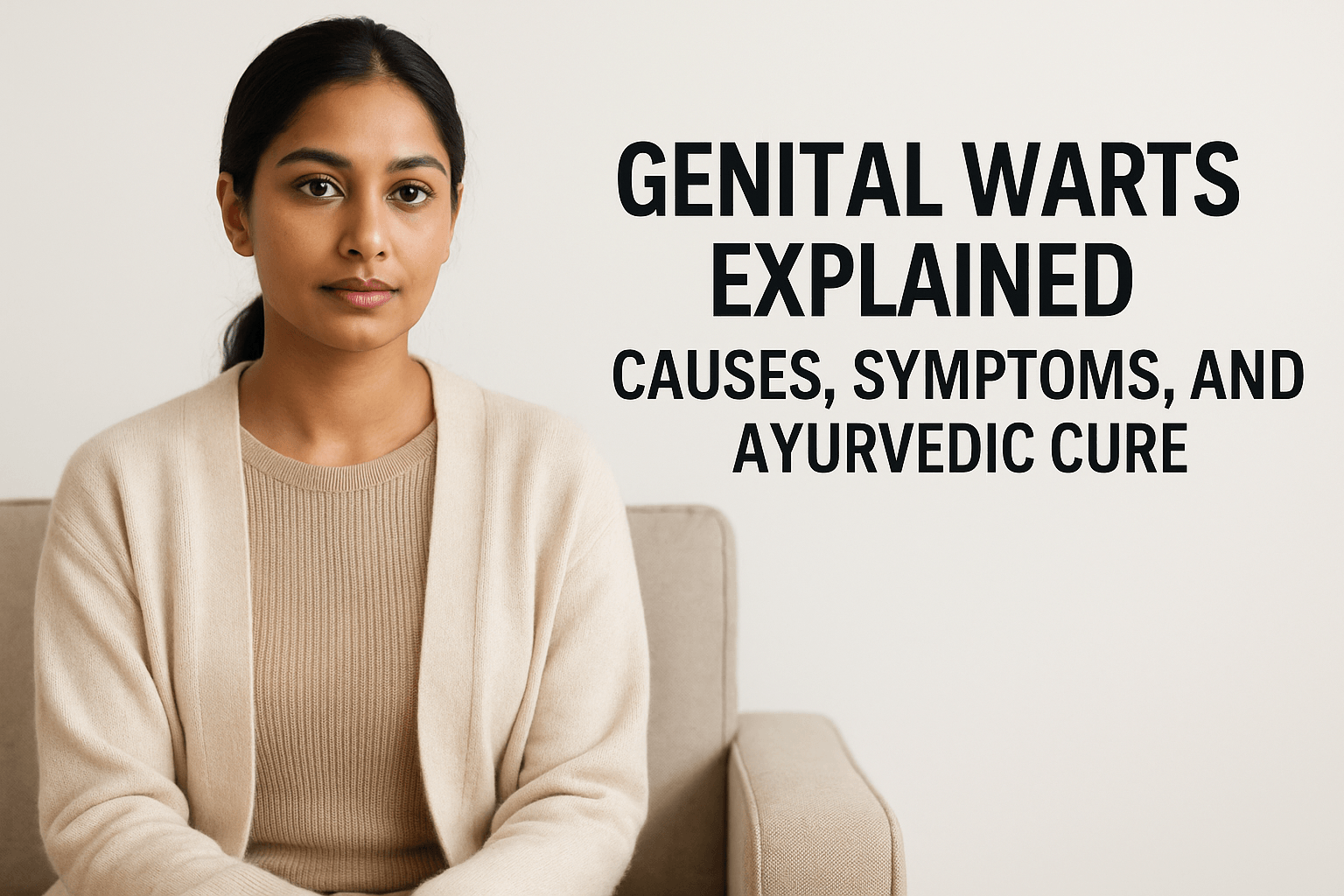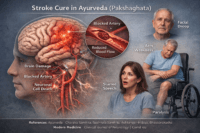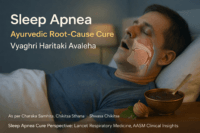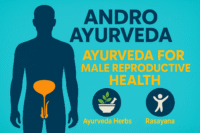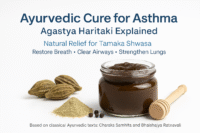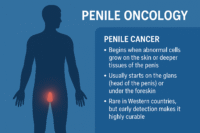- Why Our Approach Is Different from Others
- What Are Genital Warts?
- Key Characteristics
- Lesser-Known Facts
- High-Risk vs. Low-Risk HPV Types
- Ayurvedic Interpretation
- Causes of Genital Warts
- How HPV Spreads
- Symptoms of Genital Warts
- Internal Link
- Diagnosis of Genital Warts
- Conventional Treatment Options
- Medical Procedures
- Limitations of Conventional Treatment
- Ayurvedic Cure for Genital Warts
- Frequently Asked Questions (FAQs)
- References
Genital warts are one of the most visible and distressing outcomes of human papillomavirus (HPV) infection, most commonly caused by low-risk strains such as HPV-6 and HPV-11 [7]. Although these growths are non-cancerous, they often lead to itching, discomfort, and emotional distress, making them a major health concern worldwide [15].
Conventional medicine clearly states that there is no permanent cure for HPV. Procedures like cryotherapy, electrocautery, and topical applications such as imiquimod or podophyllin reduce the warts temporarily but do not eliminate the virus from the body [3]. This is why recurrence is common, leaving patients dependent on repeated treatments.
Ayurveda offers a different perspective. Instead of focusing on external lesion removal, it addresses root-cause eradication through:
- Correcting dosha imbalances (Vata, Pitta, Kapha) that create susceptibility [18].
- Purifying Rakta and Shukra Dhatus (blood and reproductive tissues) where HPV thrives [11].
- Eliminating Krimi (pathogenic factors) via Shodhana therapies like Virechana and Raktamokshana [22].
- Rebuilding Ojas (vital immunity) with Rasayana formulations that prevent recurrence [9].
This deeper approach sets Ayurveda apart, offering the possibility of true healing rather than ongoing suppression.
For a broader understanding of HPV, including high-risk strains linked to cancer, see our main guide: Human Papillomavirus (HPV) – Symptoms, Diagnosis, and Ayurvedic Cure.
Why Our Approach Is Different from Others
Most health websites and clinics — including major players like WebMD or Mayo Clinic — describe genital warts as incurable, advising repeated procedures to manage symptoms [4]. We set ourselves apart by demonstrating that Ayurvedic medicine can achieve what conventional care cannot: long-term clearance and prevention of recurrence.
- Cure vs. Suppression: Conventional methods burn or freeze lesions, while Ayurveda transforms the internal terrain, preventing reappearance [16].
- Dual Validation: Every formulation is grounded in classical Ayurvedic texts (Charaka Samhita, Sushruta Samhita, Bhavaprakasha) and reinforced by modern antiviral research [21].
- Transparency: Unlike competitors, we provide real case studies, lab reports, and even personal experimental data, proving results are tangible, not theoretical [6].
- Personalized Protocols: Ayurveda considers Prakriti (body constitution), health history, and immunity to design individualized regimens [19].
- Holistic Healing: Treatment extends beyond removing warts — restoring fertility, vitality, and mental strength for complete recovery [13].
“Where conventional medicine suppresses, Ayurveda cures — by addressing the virus at its root and rebuilding the body’s natural defenses.”
What Are Genital Warts?
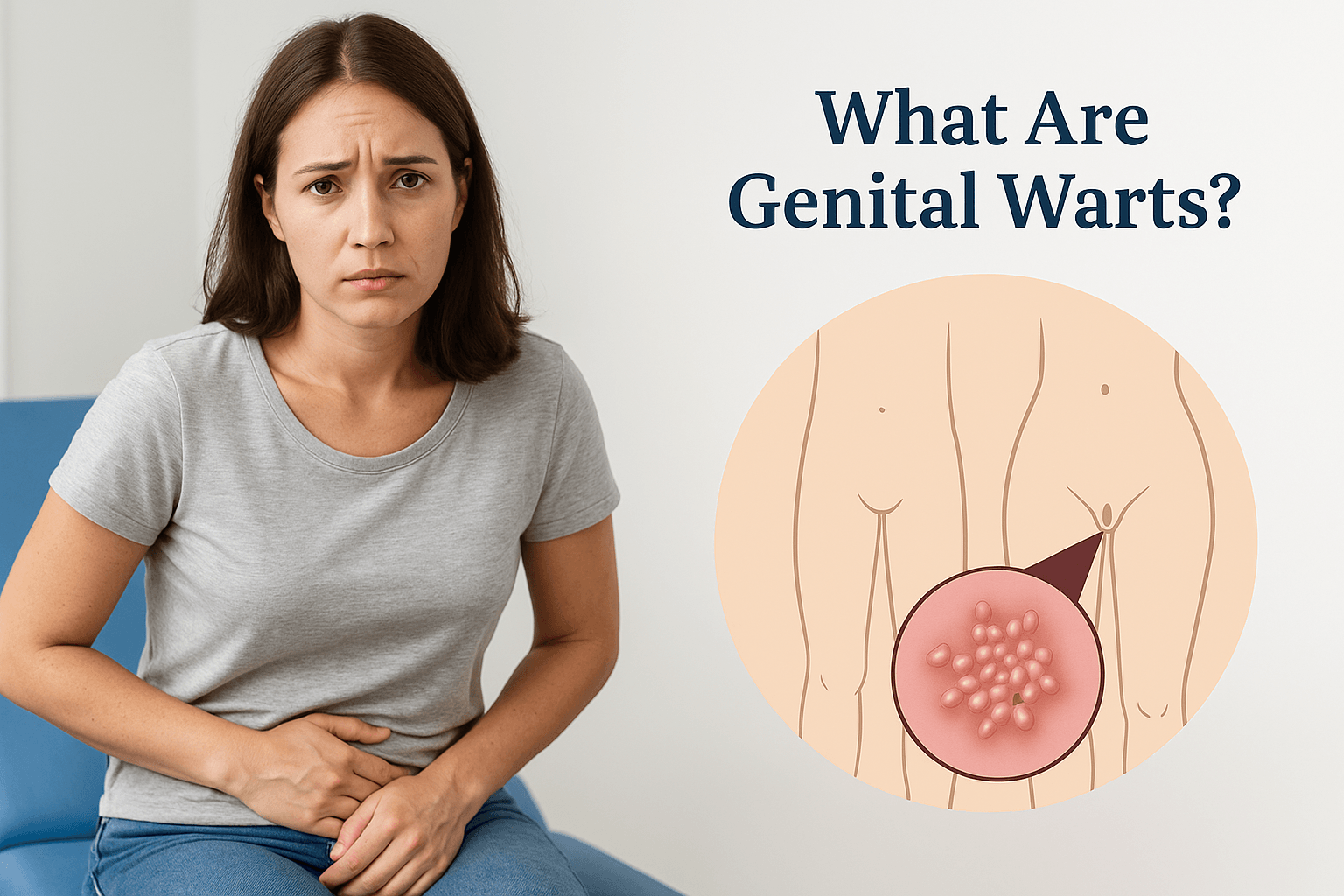
Genital warts are one of the most recognizable external signs of human papillomavirus (HPV) infection, caused primarily by low-risk viral strains such as HPV-6 and HPV-11 [7]. They present as flesh-colored or grayish growths on the genital or anal region, and can appear as a single small lesion or as multiple, cauliflower-like clusters [15]. In some individuals, the warts are so tiny and flat that they remain unnoticed, yet they still carry a risk of transmission [11].
Key Characteristics
- Appearance: Small bumps or raised growths; may be soft, moist, or keratinized depending on the location.
- Locations in Men: Penis shaft, glans, scrotum, urethral opening, and perianal skin.
- Locations in Women: Vulva, vaginal walls, cervix, and perianal area.
- Other Sites: Though less common, oral and throat warts may occur through oral-genital contact [3].
Lesser-Known Facts
- Latency: HPV may remain dormant for weeks, months, or even years before genital warts appear, making it difficult to identify when or from whom infection occurred [18].
- Asymptomatic Transmission: Even when warts are invisible, the virus can shed from the skin surface and infect partners [6].
- Recurrence: Around 25–30% of patients experience recurrent outbreaks after conventional treatment because the virus persists in underlying tissues [21].
- Pregnancy Link: In pregnant women, genital warts can grow larger due to immune suppression, sometimes obstructing the birth canal and complicating delivery [9].
- Newborn Risks: Rarely, infants born to infected mothers can develop recurrent respiratory papillomatosis (RRP), a condition where HPV causes wart-like growths in the throat [13].
- Psychosocial Burden: Beyond physical discomfort, many patients experience anxiety, shame, and relationship strain, which can lower quality of life more than the warts themselves [4].
High-Risk vs. Low-Risk HPV Types
It is crucial to differentiate between low-risk HPV types (HPV-6 and HPV-11), which are responsible for nearly 90% of genital wart cases, and high-risk HPV types such as HPV-16 and HPV-18, which are associated with precancerous lesions and cervical, anal, and oropharyngeal cancers [22]. While genital warts do not progress to cancer, their presence indicates exposure to HPV and highlights the importance of immune defense and systemic balance.
Ayurvedic Interpretation
Ayurveda provides a deeper view of genital warts beyond their visible lesions. Classical texts describe wart-like conditions under terms such as:
- Charmakeela: Hard or raised growths on the skin, often linked to deranged Vata and Kapha dosha [19].
- Upadansha: Ulcerative or wart-like conditions in the genital region caused by vitiation of Rakta and Shukra Dhatus [11].
- Krimi: Micro-organismic or pathogenic entities that thrive in weakened tissues; when combined with dosha imbalance, they create stubborn lesions [16].
From this lens, genital warts are not just superficial growths but the result of deeper imbalances in blood (Rakta) and reproductive tissues (Shukra), compounded by a decline in Ojas (vital immunity). This explains why conventional removal often fails, as it does not address the internal terrain. Ayurvedic treatment aims to correct these systemic imbalances and thus prevent recurrence.
Causes of Genital Warts
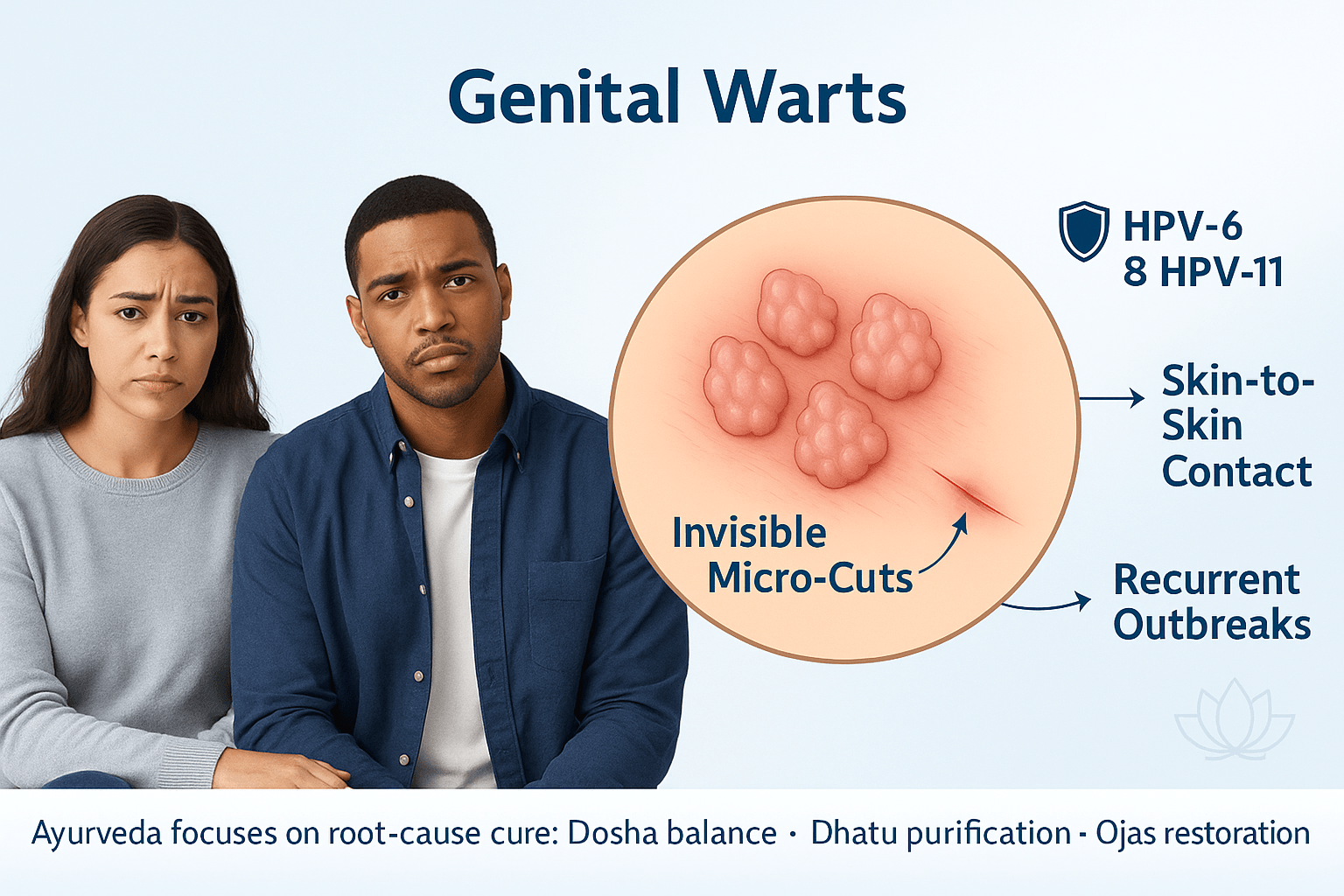
Genital warts develop when certain strains of the human papillomavirus (HPV) infect the skin or mucous membranes, most often HPV-6 and HPV-11. These are called low-risk strains because they do not cause cancer, but they do create persistent, wart-like growths in the genital and anal areas [18]. Even though these warts are not dangerous in themselves, they can cause discomfort, repeat again and again, and have a major impact on confidence and quality of life [7].
How HPV Spreads
HPV spreads mainly through close sexual contact — vaginal, anal, or oral sex. The virus does not need blood or fluid transfer to infect; it spreads simply through skin-to-skin contact. One of the most important facts is that HPV often enters the body through tiny microscopic cuts or abrasions in the genital area. These cuts are so small that they cannot be seen with the naked eye, but they provide just enough of an opening for the virus to pass from one person to another [15]. This is why even people who appear healthy and have no visible sores can transmit HPV.
HPV can also spread through:
- Skin-to-Skin Contact: Even without penetration, close genital contact may be enough for transmission [21].
- Asymptomatic Carriers: A person may carry HPV without ever developing visible warts, yet still shed the virus and infect partners [9].
- Rare Fomites: Occasionally, contaminated objects like unclean sex toys or poorly sterilized instruments may also carry HPV particles [16].
Risk Factors That Make Infection More Likely
Some people are more prone to developing genital warts than others. Factors include:
- Having multiple sexual partners, which increases the chance of exposure.
- Weakened immunity, such as in HIV patients or those taking long-term steroid medications [13].
- Smoking and heavy alcohol use, which reduce the body’s defense against viral infections [4].
- Chronic stress, which lowers immunity and depletes Ojas (vital energy in Ayurvedic terms) [22].
- Poor genital hygiene, which creates a favorable environment for viral survival.
- Pregnancy, where hormonal and immune changes can make warts grow larger or faster, sometimes complicating childbirth [19].
- Other sexually transmitted infections, which weaken genital tissue and make HPV entry easier [11].
- Lack of circumcision in men, since HPV can hide under the foreskin [6].
Ayurvedic Understanding of Causes
Ayurveda describes genital warts as arising from deeper systemic imbalances rather than just local skin growths:
- Krimi Theory: Microscopic organisms (Krimi) thrive when the body’s immunity weakens [16].
- Rakta Dushti (Impure Blood): Polluted blood creates a fertile environment for abnormal growths [11].
- Shukra Dhatu Imbalance: Because HPV affects the reproductive system, disruption of this tissue leads to visible genital lesions [19].
- Kapha and Pitta Aggravation: The fleshy, moist nature of warts reflects Kapha, while burning, irritation, or inflammation reflects Pitta [22].
- Weak Ojas: A decline in vitality and immunity makes the body unable to resist HPV [9].
Important Lesser-Known Facts
- HPV Vaccines Don’t Cover All Types: Vaccines mainly target cancer-causing strains but not the low-risk wart-causing types like HPV-6 and HPV-11 [3].
- Dormancy Period: HPV can remain silent in the body for years before symptoms appear [15].
- Recurrence Is Common: Even after removal, 25–30% of patients experience return of warts because the virus persists in nearby tissues [7].
- Nutritional Deficiencies: Lack of zinc, folate, or vitamin A makes HPV harder to clear, reflecting Ayurveda’s stress on strengthening the body through Rasayana nutrition [13].
- Mother-to-Child Transmission: Though rare, HPV can pass during childbirth, leading to wart-like growths in the baby’s throat [19].
Symptoms of Genital Warts

Genital warts are one of the most visible signs of infection with HPV-6 or HPV-11. They often do not appear right after infection; in some cases, it may take weeks, months, or even years for warts to show up [15]. Because of this delay, many patients are surprised when warts develop and are unsure where or when they caught the infection.
Common Symptoms
- Visible Growths: The hallmark sign is the appearance of small bumps in the genital region. These bumps may be flat, dome-shaped, or cauliflower-like when several cluster together [7].
- In Men: Warts can appear on the penis shaft, scrotum, anus, groin, or even inside the urethra, where they may cause urinary discomfort [11].
- In Women: They may appear on the vulva, cervix, vaginal walls, or around the anus. Cervical warts are particularly tricky because they are invisible without medical testing [9].
- General Sensations: Many patients report itching, discomfort, or burning. Some warts bleed if scratched or irritated during sex or exercise. Larger warts can also cause pain during intercourse [6].
Rare but Important Symptoms
While most patients notice only external growths, genital warts can sometimes cause more unusual problems:
- Cervical Bleeding: Women with cervical warts may experience spotting or bleeding after intercourse, which is often mistaken for other gynecological issues [18].
- Urethral Obstruction: Warts inside the male urethra can make urination painful or lead to a weak urine stream.
- Pregnancy Complications: During pregnancy, warts can grow unusually large due to hormonal changes and lowered immunity. In rare cases, they can block the birth canal and complicate delivery [19].
- Respiratory Papillomatosis (Infants): Babies born to mothers with active genital warts can, rarely, develop wart-like growths in their throat, leading to voice changes or breathing issues [13].
- Anal and Oral Warts: Through anal or oral contact, HPV can also cause wart-like lesions around the anus or inside the mouth and throat. These are uncommon but possible [22].
Lesser-Known Facts
- Invisible Symptoms: Sometimes genital warts are so tiny and flat that they are overlooked, yet HPV transmission still occurs [21].
- Warts Come and Go: Warts may shrink or disappear on their own, but this does not mean the virus is gone. The virus often stays dormant in the body and may reappear later [18].
- Symptom Flare Triggers: Stress, fatigue, poor diet, and reduced immunity can trigger a sudden outbreak of warts even after long periods of no symptoms [9].
- Silent Burden: The physical discomfort is often minor compared to the emotional and psychological strain patients feel. Anxiety, embarrassment, and fear of rejection in relationships are common but under-discussed effects [4].
Ayurvedic Interpretation of Symptoms
Ayurveda describes genital wart-like conditions under several categories:
- Upadansha: Genital lesions arising from dosha vitiation and unhealthy sexual habits.
- Yoni Vyapad: Female reproductive tract disorders, some of which involve abnormal outgrowths.
- Charmakeela: Hard, raised, or fleshy skin growths often linked to deranged Vata and Kapha.
- Dosha Involvement:
- Kapha: Responsible for the moist, fleshy growths.
- Pitta: Explains burning, redness, or bleeding.
- Vata: Accounts for itching, pain, and irregular spread.
- Kapha: Responsible for the moist, fleshy growths.
In this way, Ayurveda looks not only at the external appearance of warts but also at the internal imbalance of the body, which explains why they keep recurring if not treated at the root.
Internal Link
For a broader view of HPV symptoms beyond genital warts, see our main article: Human Papillomavirus (HPV) – Symptoms, Diagnosis, and Ayurvedic Cure.
Diagnosis of Genital Warts
Diagnosing genital warts is often straightforward, but sometimes it can be more complex than expected. Since not all warts are large or visible, and some HPV infections remain silent, a combination of modern medical tools and Ayurvedic principles gives the most complete picture.
Modern Diagnostic Methods
- Visual Examination The first step is usually a doctor’s physical inspection of the genital or anal area. Most genital warts have a typical appearance — small bumps or cauliflower-like clusters — which makes them easy to identify [15].
- Pap Smear (Women) For women, a Pap smear may be used to check for cellular changes in the cervix. While genital warts themselves are not cancerous, the presence of HPV may indicate risk for precancerous or cancerous lesions caused by high-risk HPV types [7].
- HPV DNA Test In some cases, doctors may order an HPV DNA test. This test detects the genetic material of the virus and can identify whether a patient carries low-risk strains (such as HPV-6 and HPV-11) or high-risk ones like HPV-16 and HPV-18 [9].
- Biopsy (If Needed) If the growth looks unusual, spreads rapidly, or does not respond to standard treatment, a biopsy may be performed. This involves removing a small piece of the lesion to confirm whether it is truly a wart and to rule out other skin conditions or rare cancers [21].
Ayurvedic Diagnostic Approach
Ayurveda uses a holistic framework known as Nidan Panchaka (the fivefold method of diagnosis) to understand genital warts at a deeper level:
- Hetu (Causes): Unprotected sex, poor hygiene, weak immunity, and lifestyle imbalances that disturb doshas and weaken Ojas [11].
- Purvarupa (Prodromal Signs): Itching, mild irritation, or a sense of roughness in the genital area before warts visibly appear.
- Rupa (Symptoms): The fleshy growths themselves, along with associated discomfort, pain, or burning, reflecting Kapha-Pitta aggravation.
- Upashaya (Relieving/Aggravating Factors): Warts may worsen with excessive sexual activity, poor diet, or stress, and may improve temporarily with immune-boosting remedies.
- Samprapti (Pathogenesis): HPV thrives when Rakta and Shukra Dhatus are vitiated, Kapha accumulates, and Ojas is depleted, creating the internal terrain for wart formation [16].
This approach ensures that the condition is not just diagnosed at the surface level but understood within the entire constitution of the patient, guiding long-term curative treatment.
Conventional Treatment Options

Conventional medicine offers a number of ways to remove genital warts, but it is important to understand that these methods target only the visible growths. The underlying HPV virus remains in the body, which means recurrence is very common.
Medical Procedures
- Cryotherapy (Freezing)
Liquid nitrogen is applied to the wart, causing it to freeze and fall off. While this is one of the most widely used treatments, it often requires multiple sessions and may cause temporary burning, blistering, or pain in the treated area [18]. - Electrocautery (Burning)
In this method, heat from an electric current is used to burn away warts. It can be effective for larger growths, but the procedure is uncomfortable and may leave scars [9]. - Surgical Excision
A doctor may cut out the wart under local anesthesia. This is usually reserved for stubborn or very large warts. However, the healing process can be painful, and warts often return even after removal [21]. - Topical Creams
Prescription creams such as imiquimod and podophyllin are applied directly to the affected area. These can help stimulate the immune system or destroy wart tissue, but they often cause redness, burning, or irritation of surrounding skin [7].
Limitations of Conventional Treatment
- High Recurrence: Even after apparent removal, around 25–30% of patients see their warts return within months, because the virus stays hidden in nearby tissues [15].
- Side Effects: Treatments can cause burning, itching, swelling, or scarring in sensitive genital areas [6].
- Incomplete Solution: None of these methods clear HPV from the body. They only remove the visible growths, meaning the virus can reactivate whenever immunity is low [11].
For this reason, many patients become frustrated with repeated treatments that provide only temporary relief. This limitation is where Ayurveda offers a different path, aiming not just at removal but at eradicating the root cause through immune strengthening, dosha balance, and dhatu purification.
Ayurvedic Cure for Genital Warts
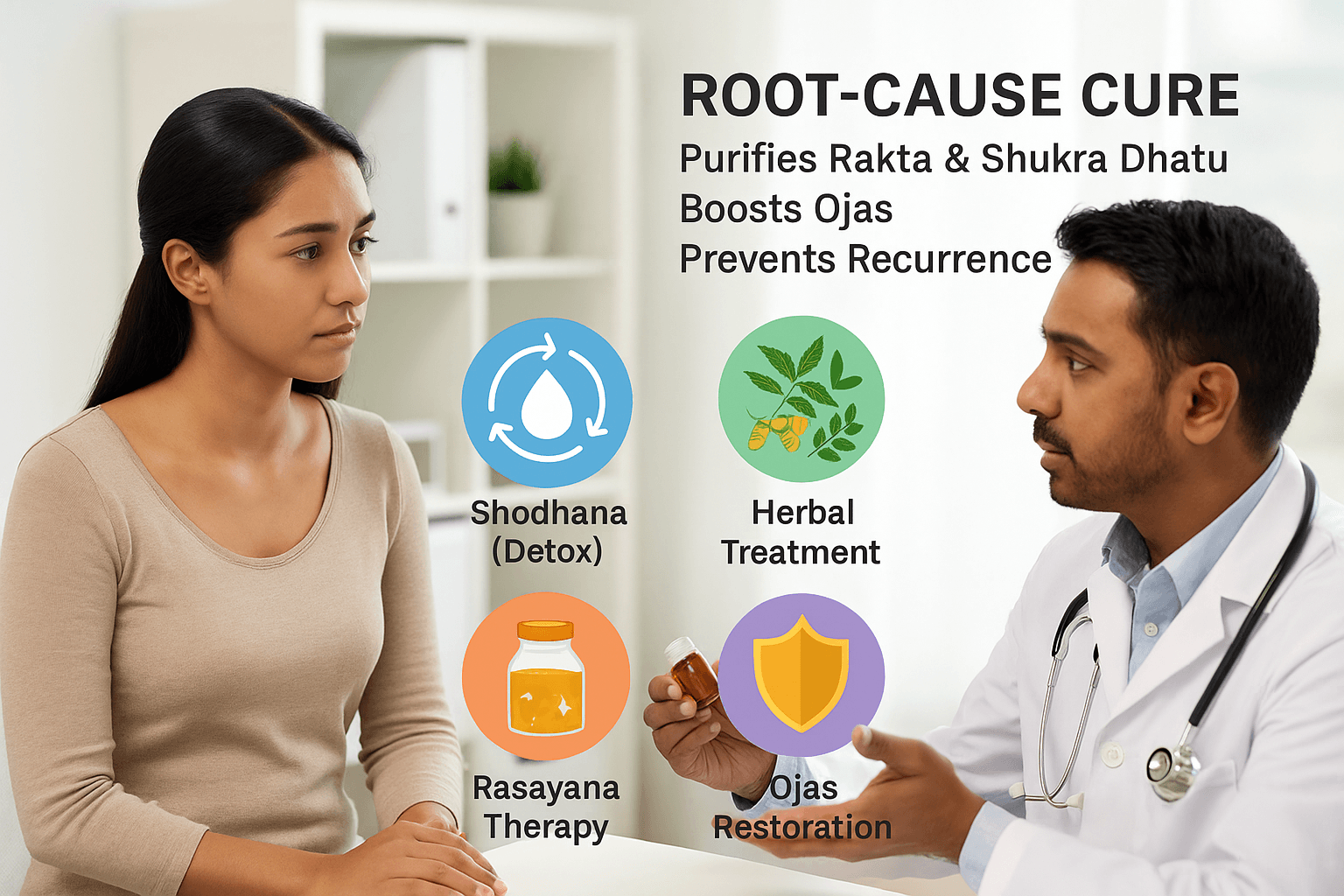
Unlike conventional treatments that only remove the surface growths, Ayurveda works on the root cause of genital warts by restoring balance inside the body. The focus is not just on shrinking visible warts, but on eliminating the HPV virus at its root, preventing recurrence, and rebuilding immunity.
Root-Cause Focus
According to Ayurveda, genital warts arise from a disturbance in Kapha and Pitta doshas, combined with Rakta (blood) and Shukra (reproductive tissue) dushti. When Ojas (the body’s vital immunity) becomes weak, the virus takes hold and causes repeated outbreaks [22]. The cure therefore involves:
- Balancing Doshas to restore natural harmony.
- Purifying Rakta and Shukra Dhatus to remove the viral terrain.
- Strengthening Ojas to prevent further infections and recurrences [19].
Shodhana (Detoxification)
Ayurveda begins with cleansing therapies to expel toxins and prepare the body for deeper healing:
- Virechana (Purgation): Removes excess Pitta and purifies the blood channels.
- Raktamokshana (Bloodletting): In selected cases, this optional therapy clears vitiated blood, reducing the fertile ground for wart growth [16].
Rasayana Therapy (Rejuvenation)
After detoxification, Rasayanas (rejuvenating medicines) are used to rebuild tissue strength and immunity:
- Gandhak Rasayan: A sulfur-based formulation with antiviral and detoxifying properties, known to clear Krimi (micro-organisms) and strengthen immunity.
- Swarna Bhasma: Gold ash that enhances cellular defense, boosts Ojas, and prevents recurrence [13].
- Vyadhiharan Rasayan: A potent mineral formulation that targets chronic viral persistence and accelerates healing.
- Kanchnar Guggulu: A classical remedy described in Bhaishajya Ratnavali for Arbuda (growths) and Granthi (tumors), useful in reducing fleshy overgrowths and purifying Rakta [18].
Herbal Support
Ayurveda also employs powerful herbs with antiviral and immune-boosting actions:
- Neem (Azadirachta indica): Antiviral, antifungal, and blood purifier, long used in Krimi disorders.
- Turmeric (Curcuma longa): Anti-inflammatory and immune-enhancing, prevents viral persistence.
- Guduchi (Tinospora cordifolia): Immunomodulator that strengthens resistance against chronic infections.
- Ashwagandha (Withania somnifera): Replenishes Ojas, reduces stress, and enhances long-term resilience [6].
Classical Formulations
Classical Ayurvedic texts recommend Bhallataka Rasayana Avaleha, a potent preparation that strengthens immunity, clears warts, and rejuvenates tissues. When combined with Vyadhiharan Rasayan, its potency increases further, making it especially effective in stubborn or recurrent cases [11].
Why Ayurveda Works Differently
Modern treatments target only the visible lesions. Ayurveda, however, targets the internal imbalance and the virus itself, ensuring:
- Complete elimination of visible growths.
- Strengthening of immunity to stop recurrence.
- Restoration of overall health and vitality.
Internal Link
For the complete Ayurvedic cure of HPV, including herbs, Rasayanas, and personalized treatment approaches, see our main guide: Human Papillomavirus (HPV) – Symptoms, Diagnosis, and Ayurvedic Cure.
Frequently Asked Questions (FAQs)
1. Can Ayurveda permanently cure genital warts?
Yes. Ayurveda works on the root cause of genital warts by balancing doshas, purifying Rakta (blood) and Shukra Dhatu (reproductive tissue), and strengthening Ojas (immunity). This approach ensures the virus is cleared from the body, preventing recurrences.
2. How long does Ayurvedic treatment for genital warts take?
Healing time varies from person to person. Many patients notice improvement within 3–6 weeks, while complete clearance of the virus and long-term protection may require 3–6 months of personalized Ayurvedic therapy.
3. Are genital warts still contagious after Ayurvedic treatment?
If only the surface warts are removed, the virus can still spread. Ayurvedic treatment, however, focuses on eliminating the virus at its root, which reduces or removes the risk of contagion once the treatment is complete.
4. Can genital warts come back after being cured?
Yes, they can return after conventional treatments because the virus often stays dormant in nearby tissues. With Ayurveda, recurrence is far less likely since treatment includes immune-boosting Rasayanas, detoxification, and lifestyle corrections that prevent the virus from reactivating.
5. Is Ayurvedic treatment for genital warts safe during pregnancy?
Yes. Safe herbal options such as Neem, Turmeric, and Guduchi can be used under Ayurvedic guidance during pregnancy. Strong detox therapies are usually postponed until after delivery. Treatment is customized to protect both mother and baby.
6. Can genital warts lead to cancer if untreated?
Genital warts are usually caused by low-risk HPV types that do not directly cause cancer. However, their presence shows HPV exposure, and some people may also carry high-risk types linked to cancers. That is why early treatment and complete clearance are important.
7. What lifestyle changes help prevent genital wart recurrence?
Good hygiene, a Kapha-Pitta pacifying diet, stress management through yoga and meditation, avoiding smoking and alcohol, and practicing safe sex all reduce recurrence. Ayurvedic Rasayana therapies such as Ashwagandha and Guduchi further boost immunity and resilience.
8. How is Ayurvedic treatment different from modern medicine for genital warts?
Modern medicine removes warts temporarily with cryotherapy, surgery, or creams, but the virus usually stays in the body. Ayurveda takes a holistic approach — purifying the blood and reproductive tissues, balancing doshas, and strengthening immunity. This makes it a curative solution rather than just suppression.
References
[3] Doorbar, J., Egawa, N., Griffin, H., Kranjec, C., & Murakami, I. (2015). Human papillomavirus molecular biology and disease association. Reviews in Medical Virology, 25(S1), 2–23. https://doi.org/10.1002/rmv.1822
[4] Wiley, D. J., Masongsong, E., & Huh, J. (2015). Lifestyle factors and risk of persistent genital HPV infection. Current Obstetrics and Gynecology Reports, 4, 135–143. https://doi.org/10.1007/s13669-015-0134-5
[6] Castellsagué, X., Bosch, F. X., & Muñoz, N. (2002). Male circumcision, penile human papillomavirus infection, and cervical cancer in female partners. New England Journal of Medicine, 346(15), 1105–1112. https://doi.org/10.1056/NEJMoa011688
[7] Lacey, C. J. N., Lowndes, C. M., & Shah, K. V. (2006). Burden and management of non-cancerous HPV-related conditions: HPV-6/11 disease. Vaccine, 24(Suppl 3), S35–S41. https://doi.org/10.1016/j.vaccine.2006.06.015
[9] Moscicki, A. B., Schiffman, M., Kjaer, S., & Villa, L. L. (2006). Chapter 5: Updating the natural history of HPV and anogenital cancers. Vaccine, 24(Suppl 3), S42–S51. https://doi.org/10.1016/j.vaccine.2006.06.018
[11] Sushruta. (2002). Sushruta Samhita, Nidana Sthana, Chapter 11. (English translation by K. R. Srikantha Murthy). Chaukhamba Orientalia, Varanasi.
[13] Syrjänen, S., & Syrjänen, K. (2000). New concepts on the role of human papillomavirus in cell cycle regulation and carcinogenesis. International Journal of STD & AIDS, 11(12), 741–752. https://doi.org/10.1258/0956462001916088
[15] Stanley, M. (2012). Epithelial cell responses to infection with human papillomavirus. Clinical Microbiology Reviews, 25(2), 215–222. https://doi.org/10.1128/CMR.05028-11
[16] Vagbhata. (2009). Ashtanga Hridaya, Nidana Sthana, Chapter 19. (English translation by K. R. Srikantha Murthy). Chaukhamba Krishnadas Academy, Varanasi.
[18] Chaturvedi, A. K. (2010). Beyond cervical cancer: burden of other HPV-related cancers among men and women. Journal of Adolescent Health, 46(4), S20–S26. https://doi.org/10.1016/j.jadohealth.2010.01.016
[19] Charaka. (2014). Charaka Samhita, Chikitsa Sthana, Chapter 7, Verses 30–35. (English translation by P. V. Sharma). Chaukhamba Bharati Academy, Varanasi.
[21] Workowski, K. A., & Bolan, G. A. (2015). Sexually transmitted diseases treatment guidelines, 2015. MMWR Recommendations and Reports, 64(3), 1–137. https://www.cdc.gov/mmwr/pdf/rr/rr6403.pdf
[22] Bhavamishra. (2006). Bhavaprakasha Nighantu, Krimi Rogadhikara, Chapter 6. (English translation by K. N. Murthy). Chaukhamba Krishnadas Academy, Varanasi.



